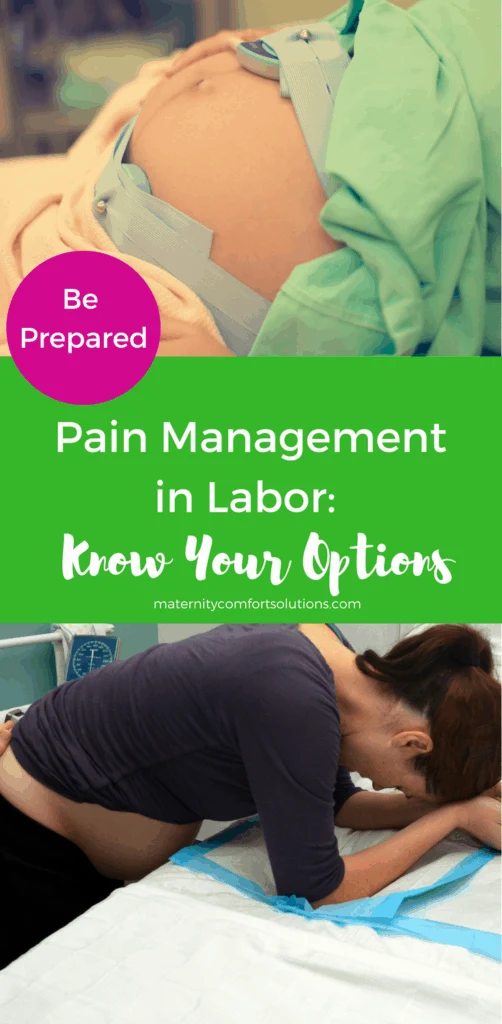
Management of Pain During Labor
To reduce anxiety and feel in control during the course of your pregnancy, the importance of thoroughly researching the management of pain during labor cannot be overstated. REGARDLESS of how you plan your management of pain during labor, just knowing your options can make all the difference.
 This post may contain affiliate links, you can catch our full disclaimer at the bottom of this post.
This post may contain affiliate links, you can catch our full disclaimer at the bottom of this post.
The management of pain during labor is a topic that is frequently discussed for many reasons:
- There are many options available
- There are many opinions among family, friends and health care providers
- People have different core values
- Risk tolerance is not the same for everyone
- Cultural differences
(The above list is noted, to simply point out why there will always be discussions and disagreements about the management of pain during labor. There will never be universal agreement about the management of pain during labor and that is absolutely fine. Unfortunately, it is the strongly opinionated individuals that can cause confusion for the expectant couple. Individuality and the freedom to choose will always result in different approaches to pain management during labor. There is no right or wrong answer. What is most important is to accept this fact and be open-minded.)
For the expectant parent, it is important to:
- Not internalize others opinions about the choices you make
- Not care how others perceive or judge you based on the choices you make
To properly discuss the topic of pain management during labor, it is also necessary to have a mutual understanding of what “natural childbirth” is in 2018. There are two definitions circulating, depending on who you talk to and the context of the conversation:
- For many, natural childbirth means going through labor and delivery without pain medication.
- For others, the term is used to distinguish a vaginal delivery from a cesarean section.
Some individuals, particularly health care providers, might suggest that the distinction noted above does not exist. However, after many years in practice, talking directly with thousands of expectant mothers, it is an absolute fact that there are two interpretations of natural childbirth among expecting parents. This is not a bad thing at all, but it must be acknowledged if this post is to prompt a meaningful discussion. Everyone must be on the same page when discussing pain control options.
Lastly, it is important to emphasize the fact that a cesarean section should NEVER be viewed as a failure on the part of the laboring patient. Unscheduled cesarean sections are performed for only one reason and that is to make sure childbirth results in a healthy newborn and mother.
The conventional medical community does not want to do cesarean sections. Sadly, there is are a lot of discussions leading many to believe otherwise. Moms who are not able to deliver vaginally for clearly indicated, life-saving reasons (very large baby, hemorrhage, fetal distress, placental abruption, etc.), are often left to believe they have “failed” at childbirth. Mothers should be supported after going through childbirth regardless of the mode of delivery.
(As a retired obstetrician, I MUST note that this is not about whether the indications for a cesarean section were appropriate or not. This is about a mother making her own educated decision and fulfilling her wishes while administering appropriate medical care.)
As for pain control options, consider the aforementioned information, groundwork to prompt an accurate and thorough discussion. The outcome of the discussion should leave an expectant mother/couple feeling comfortable with their decision.
So What Are The Pain Management Options Available During Labor?
First, keep in mind that the options listed are in no way all-inclusive. This is a result of three very important factors:
- Variations exist for the different forms of pain management
- New methods for pain management are constantly being developed
- Pain management can use a combination of treatments
What is most important throughout this process, is to be mindful of the fact that no one is right or wrong when it comes to the management of pain during labor (assuming all options being considered are accepted and safe standards of medical care).
No woman should be left to feel her decision is wrong or be judged in any way for simply being her own advocate and choosing what fits her belief system and desired level of comfort throughout the labor and delivery process. When an expectant mother is left feeling guilty about her choice, the effect can be emotionally damaging.
Disagreements should never leave a mother/couple feeling inadequate or noncompliant. An expecting mother must feel empowered and in control throughout the birth experience. It is interesting to note that laboring patients who feel in control often desire less pain medication during labor simply because they know what is available and feel they can freely request pain medication, not fearing they will be judged. Choosing pain control during labor is an option that every laboring patient should be able to make for herself.
The following is a list of the various treatments available, with the understanding that this list is constantly changing.
The list is not all-inclusive and access to the various options will vary based on where you deliver and what your provider offers (a discussion, which must take place at your first prenatal visit). The video to follow is a tremendous resource to help understand the pain control options in more detail.
Your decision for pain control, be it breathing techniques or regional anesthesia, is a decision that only you can make and should be based on what YOU want! The following are pain management options you should discuss with your prenatal care provider.
NON-PHARMACOLOGIC
This approach to pain management focuses on meditation, mindfulness and breathing techniques. Control of pain at this level is addressed using skills learned through education, knowing what to expect and remaining in control throughout the labor process. Being prepared and knowing what to expect is the most important part of pain management, regardless of whether one chooses to receive medication as labor progresses.
PHARMACOLOGIC
Pharmacologic therapies can encompass a number of medications (narcotics etc.).
REGIONAL ANESTHESIA
Epidural – catheter-infused nerve block that can be regulated throughout labor
Spinal anesthesia – one-time injection nerve block administered at the time of delivery
Pudendal Nerve block – local pelvic nerve block administered at the time of delivery
GENERAL ANESTHESIA
Very rarely used (only for emergent delivery) when regional anesthesia is not in place and time does not allow for any form of regional block.
The bottom line about pain control is this: No one is right or wrong when it comes to the management of pain during labor (assuming all options being considered are accepted and safe standards of medical care). The delivering patient should be supported and offered unbiased information about pain control during labor. Along this same line, no woman should be left to feel their decision is wrong or in any way defines her as “less of a mother” simply because she wants to be her own advocate and choose what fits her belief system and desired level of comfort throughout the labor and delivery process. If this fundamental approach is not followed, the guilt that new mothers are often left with can be emotionally damaging.
An expecting mother must feel empowered and in control throughout the birth experience. It should be no surprise that laboring patients who feel in control often desire less pain medication simply because they know it is available and do not fear to ask for it for fear of being judged.
This video by Catherine Tsai MD is extremely informative!
Courtesy of Catherine Tsai MD
***** This notation is to explain why an early prenatal discussion about pain control during labor is so critical. Assume you have a medical condition involving your back (scoliosis etc.) or have experienced a back injury. In this situation, if you were to want regional anesthesia (ie. epidural, spinal) the obstetric anesthesiologist would want to talk with you about your options (risks/benefits, etc.) when you are not in active labor (only to find out that regional anesthesia is not an option). The benefit of a consultation with an anesthesiologist long before your delivery, in a situation such as this, is invaluable. Bleeding disorders are another example where a pre-anesthesia consultation is appropriate.


